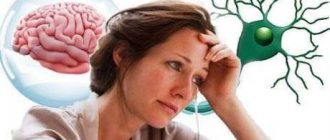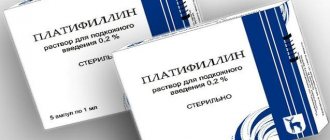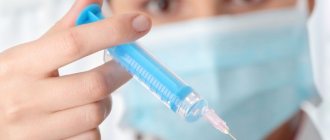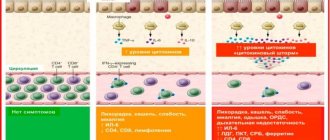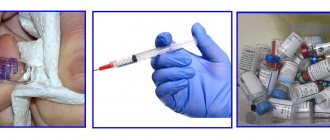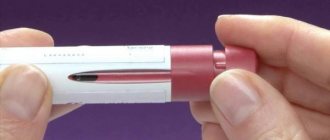- November 4, 2018
- Other drugs
- Gena Poddubny
In this article we will look at the instructions for using Imunofan.
Currently, there are a number of diseases against the background of which the human immune system is not able to cope on its own in the fight against a particular disease and requires, first of all, pharmacological support, that is, the use of medicinal drugs with the appropriate effect. A drug called “Imunofan”, which stimulates the immune system, has found widespread use for people and animals. The medicine also protects liver cells by binding free radicals to many other toxins in the body. Latin name - Imunofan.
Basic information about the drug
The product "Imunofan" belongs to the production, it is a modern effective immunomodulator. Its effect is based on achieving three main pharmacological effects at once: adjusting the immune system along with restoring the balance of the body’s oxidative and antioxidant reactions, combined with increasing the absorption of medications for a number of serious diseases (including cancer). The presented drug effectively suppresses the multidrug resistance of tumor cells and increases their sensitivity to the effects of cytostatic agents.
The scope of this medicine in medicine is very wide. "Imunofan" is used in pediatrics, in the treatment of psoriasis and allergies, in the field of gynecology and in the treatment of pulmonary diseases. One of the main areas of use of the drug is the treatment of a number of chronic viral infections, including hepatitis.
The Binox scientific production enterprise, which was founded almost thirty years ago by a group of scientists at the research laboratory of biotechnology and immunology of the Central Ministry of Health of Russia, is the developer and main supplier of this medicine.
What can you learn from the instructions for Imunofan?
Pharmacological effects
According to the instructions for use, “Imunofan” has pronounced immunostimulating, antioxidant, detoxification and hepatoprotective (protecting liver cells) properties. This medication is able to suppress the development of cellular resistance to antitumor drugs.
As an oligopeptide immunostimulant, this medicine can produce immunoregulatory, detoxification and hepatoprotective effects by inactivating peroxide and free radical compounds. The effect of the drug is based on the normalization of the oxidative, antioxidant and immune systems of the human body. The action usually begins after three hours and lasts up to four months.
Against the background of the fast phase (its duration is usually about two to three days), first of all, a detoxification property appears, and at the same time the antioxidant defense of the body is further enhanced by stimulating the production of ceruloplasmin. A similar effect is also caused by lactoferrin and catalase activity. It is worth noting that this drug quickly normalizes lipid peroxidation, suppressing the destruction of cell membrane phospholipids with the synthesis of arachidonic acid. Patients then experience a subsequent decrease in cholesterol concentrations along with the production of inflammatory mediators. Against the background of toxic and infectious liver damage, this drug prevents cytolysis and reduces the activity of transaminases with the concentration of bilirubin in the blood serum.
Against the background of the middle phase (this begins after three days, and its duration is up to seven to ten days), there is a significant increase in the phagocytosis reaction in combination with the death of intracellular viruses and bacteria. During the activation of phagocytosis, a slight exacerbation of areas of chronic inflammation occurs, maintained through the persistence of bacterial and viral agents.
During the slow phase (which begins on the tenth day and lasts up to four months), the immunomodulatory effect of this drug appears. For example, there is a restoration of impaired humoral and cellular immunity, along with an increase in the production of specific antibodies.
The effect on the production of specific antibacterial and antiviral antibodies is equivalent to that of some therapeutic vaccines. Unlike the latter, the presented medicine does not have any significant effect on the production of reagin antibodies of the IgE class and there is no increase in immediate hypersensitivity. Stimulation of IgA formation may occur in the presence of congenital deficiency.
The effect of the drug does not depend in any way on the production of PgE2; the drug can be prescribed in combination with anti-inflammatory drugs (non-steroidal and steroidal).
special instructions
Since Imunofan has the ability to activate phagocytosis, its use may exacerbate chronic inflammation, but it does not last long.
Impact on the ability to drive vehicles and complex mechanisms
While using Imunofan, you can freely get behind the wheel and work with complex mechanisms, since the drug does not in any way affect the reaction speed and concentration of attention.
Drug interactions
Imunofan increases the therapeutic effect of jointly used medications. It is recommended to combine it with medications prescribed against inflammation (non-steroidal). This immunomodulator also increases the body's sensitivity to glucocorticosteroids.
As part of complex therapy, the drug is used throughout the entire period of treatment of stages 3 and 4 of oncology, while its task is to weaken pathogenic cells and make them more sensitive to the drugs used.
No negative reactions were recorded during the combined use of Imunofan with other drugs.
Alcohol compatibility
During the period of use of Imunofan, it is recommended to avoid the consumption of alcoholic beverages, since studies on the compatibility of ethanol with the described drug have not been conducted.
Use during pregnancy and lactation
The drug is contraindicated during pregnancy with Rh conflict between mother and fetus.
During uncomplicated pregnancy and during breastfeeding, Imunofan is allowed to be taken only under the supervision of a specialist, since the possibility of its negative effects on the child’s body has not been determined.
Prescription for children
The medication is allowed to be used by children over two years of age.
Release forms: suppositories, spray and injections
In accordance with the instructions for use, “Imunofan” is available in the form of an amorphous, odorless, white powder. The following pharmacological forms are prepared on its basis:
- A solution in ampoules intended for injection into the muscle and under the skin (corresponds to a dosage of the active ingredient of 50 micrograms). A package may contain five or ten pieces. The solution resembles a colorless transparent liquid.
- In addition to injections, there is also a suppository format, which are supplied in ten pieces per package. Instructions for use for Imunofan suppositories are included in each pack.
- This medicine is also produced in the form of an intranasal metered spray in 8.5 milliliter bottles (one dosage contains 50 micrograms of the active ingredient).
It is worth noting that in the case of Imunofan, there are no other forms of release, such as pills or drops for internal use.
Terms of sale and storage
You can purchase the drug at a pharmacy only if you have a prescription form filled out by your attending physician.
Imunofan is stored for two years in a dark, dry place out of reach of children. Recommended air temperature is from two to ten degrees. The use of the medicinal product after the stated expiration date is prohibited.
The price of the injection form of the drug is 500-700 rubles per pack of five ampoules, suppositories – 450-600 rubles per pack with five suppositories, nasal spray – 900-1200 rubles per bottle. In veterinary pharmacies the medicine is sold at a price of 260-300 rubles per package containing 5 ampoules.
Indications
As the instructions for use indicate, “Imunofan” is used for the purpose of prevention and therapy for immunodeficiency states of various origins in children and adult patients. In addition, the presented medicine is advisable to use in the following situations:
- As part of the combined treatment of various tumors.
- With papillomavirus infection of the oral cavity, pharynx or larynx.
- Against the background of various infections (herpes simplex virus, toxoplasmosis, chlamydia, pneumocystosis, etc.).
- As part of complex treatment of HIV infection along with chronic viral hepatitis, treatment of burns, septic endocarditis.
- For wounds that do not heal for a long time.
- Against the background of various purulent and septic complications.
- With bronchial obstruction syndrome.
- If the patient develops cholecystopancreatitis, rheumatoid arthritis, psoriasis or diphtheria.
Indications and contraindications for use
Specialists can prescribe Imunofan in the following cases:
- immunodeficiency;
- toxic poisoning;
- as one of the means in the complex treatment of hepatitis B and C, as well as HIV and AIDS;
- as an aid in the fight against cancer;
- opportunistic infections;
- tumors provoked by the human papillomavirus;
- rheumatoid type arthritis;
- diphtheria;
- brucellosis;
- psoriasis;
- bacterial inflammation of the inner lining of the heart;
- severe skin damage (wounds or burns) that do not heal for a long time;
- during immunization as an adjuvant.
Contraindications include:
- conflict pregnancy (Rhesus mismatch between mother and fetus blood);
- children under two years of age;
- high sensitivity to the components of the product.
Instructions
"Imunofan" is usually used for intramuscular, subcutaneous, intranasal and rectal administration. The method of its administration, along with the duration of treatment and the required dosage, is selected individually, taking into account contraindications and indications. Injections are usually prescribed in courses. The single and daily dose is fifty micrograms.
The instructions for use for Imunofan injections confirm this.
Rectal suppositories are placed into the rectum once a day, one hundred microgram suppository.
According to the instructions for use, Imunofan spray is sprayed in each nasal passage, one dose. The maximum daily intake is 200 micrograms. If a patient has oncology of various locations as part of combination therapy (for example, during surgery in combination with chemotherapy), the medication is prescribed for the entire recovery period in courses of ten days, followed by a break of twenty days. The method of administration is as follows:
- 1 milliliter into the muscle or under the skin once a day.
- One suppository once a day.
- Intranasally only once a day, one dosage.
In children with malignant lesions of the lymphoid and hematopoietic systems, Imunofan is prescribed in the form of suppositories of 100 micrograms once, for a course of ten to twenty days. In the presence of HPV in children with lesions of the oropharynx and larynx, 1 milliliter is prescribed intramuscularly or as a suppository once a day for ten days. In the presence of chlamydia, herpes and other similar infections, usually use one dose of nasal spray twice a day, lasting from ten to fifteen days. Or one milliliter of “Imunofan” by injection subcutaneously or into a muscle for twenty days. The course of therapy is repeated after two or four weeks.
For the treatment of psoriasis, one suppository is used once a day in the rectum for fifteen to twenty days. When a cold occurs, which occurs against the background of severe immunodeficiency states and is accompanied by an intoxication symptom, as well as in the complex treatment of chronic and acute inflammatory infectious pathologies, “Imunofan” is prescribed one dose of spray once a day, for 10-25 days.
For chronic viral hepatitis, use one suppository rectally once a day for twenty days, or 1 milliliter subcutaneously or intramuscularly only once every three days (for a course of ten injections). In order to prevent relapses, the course is repeated three months after the start of treatment. If diphtheria is present, use one suppository rectally once a day for ten days. If HIV infection is confirmed, as part of complex therapy, it is necessary to use one suppository rectally once a day for twenty days. Repeat treatment will be required after four weeks.
When bronchial obstruction syndrome or rheumatoid arthritis occurs, one rectal suppository or 1 milliliter by intramuscular route is prescribed.
The instructions for Imunofan injections must be strictly followed.
The drug is used once every three days. In total, you need to use eight to ten suppositories or Imunofan injections.
If necessary, therapy is extended to twenty suppositories (injections). When receiving burns, as well as against the background of a surgical purulent septic complication, use one suppository rectally once a day for ten to twenty days.
Imunofan and alcohol
The compatibility of Imunofan and alcohol can cause deterioration in overall health. The effect of such treatment will not be achieved. The disease continues to progress. People with alcohol dependence should abstain from alcohol during therapy and undergo a full examination. Excessive stress on organs sometimes leads to death.
↑ Use search Are you having a problem? Need more information?
Type in the form and press Enter!
These substances do not mix with each other. If taken together there will be negative health consequences.
Among them:
- The appearance of edema.
- Deterioration incompatible with life.
Based on this, doctors are unanimous in the opinion that the drug cannot be combined with alcoholic beverages. The effect of the drug is reduced under the influence of ethanol, and the therapy does not bring any benefit.
↑
Take the Attention Test! Find 10 differences! (click right here!)
Brief characteristics of the drug
The medicine belongs to the group of immunomodulators.
Available in:
- nasal spray;
- injections for injections;
- rectal suppositories.
Indications:
- acute and chronic infectious and inflammatory diseases;
- immunodeficiency and toxic conditions;
- period after operations and chemotherapy.
- prevention of ARVI and other viral diseases.
Contraindications:
- Children under two years of age are not allowed.
- Hypersensitivity to the components of the drug.
Prescribe medication with caution during pregnancy and breastfeeding. For chronic hepatitis, an individual dosage is prescribed.
Its action is:
- Correcting the state of the immune system.
- Normalization of oxidative-antioxidative reactions.
- Overcoming tumor cell resistance to other drugs.
The effect of the drug is divided into three phases:
- Fast - the effect begins within two hours after administration and lasts three days.
- Medium – the effect lasts up to 10 days.
- Slow - starting from the tenth day and for about four months.
The patient's body responds well to the combination of taking the drug with non-steroidal anti-inflammatory drugs and steroids.
↑https://myweak.ru/alkogolizm/lekarstva/imunofan-sovmestimost.html
Use of the drug for alcoholism
After prolonged consumption of products containing ethyl alcohol, the intestines stop producing endogenous alcohol necessary for digestion. Thus, a person experiences a craving for ethanol because the body requires it - a dangerous disease, alcoholism, is acquired.
Despite the fact that alcohol is always present in the human body, which performs useful functions (psychological protection and control of the central nervous system), drinking alcoholic beverages does not bring benefits. If you combine it with any medicine, it will only get worse for the person.
Doctors advise completely abstaining from drinking alcohol during therapy and preventive measures. An alcoholic must be examined and receive a doctor's prescription before starting to take the drug.
↑
Using the drug for a hangover
Alcohol disrupts liver function, impairs immunity, and negatively affects the nervous system, brain function and mental state. However, moderate alcohol consumption will not bring serious health consequences - people are mistaken.
After all, even after drinking a small amount, a person experiences a lot of unpleasant sensations the next day, and sometimes after just a few hours:
- Weakness, dizziness, inability to sleep - disruptions in the functioning of the central nervous system.
- Nausea and vomiting are a burden on the gastrointestinal tract.
- Pain in the eyes, dry mouth - impaired blood pressure and dehydration.
- Intolerance to bright light, loud sounds - reflex abilities are affected.
- Sometimes diarrhea and abdominal pain are caused by damage to the stomach.
All symptoms indicate that the body has been subjected to severe stress. This period is called a hangover or post-toxication syndrome.
You should not take medicine at this time. The body is busy removing toxins (ethanol breakdown products) beyond its limits. But at the same time it must somehow respond to interference in the drug process. A reaction occurs that worsens the condition, since treatment in this case will lead to greater failure of the organs.
↑
Consequences of drinking alcohol
Alcohol neutralizes the beneficial effect of the drug, treatment becomes ineffective. Viruses and infections continue to multiply.
Despite the fact that the drug does not have serious side effects, with the exception of individual intolerance, taking the drug and alcohol together worsens the person’s condition.
Ethanol breakdown products destroy immunity, which is always low in drinkers, and inhibit the functioning of the liver, nervous system and endocrine glands - because of this, the production of antibodies to the disease is reduced.
Of the negative health consequences (except death) after such treatment with the addition of alcohol:
- Quincke's edema;
- allergic reactions, inflammation;
- sharp deterioration of the disease.
These consequences apply to all types of the drug without exception.
↑
When can you take the drug, after how long
You can take the drug only after complete removal of ethanol breakdown products from the body. On average, small amounts of mild alcohol are eliminated within 24 hours. Doctors recommend starting treatment at least two days after drinking a strong drink.
↑
When can you drink alcohol if you are taking or have taken the drug?
How long after you can drink alcohol after treatment will be determined by your attending physician. On average, it is advised to wait a month after the last dose.
The minimum period after which you can start drinking strong drinks is a week. But it all depends on the person’s condition, which is determined by a medical specialist.
↑
Imunofan and beer
You cannot combine Imunofan and beer, because the risk of developing side effects of the drug increases.
Among which are:
- the appearance of various types of edema;
- allergy;
- deterioration of the patient's well-being;
- reduction of therapeutic effect.
The last complication is considered the most dangerous, because in the absence of the necessary treatment, the body with reduced immunity is attacked by a severe infection. Unable to cope with the load, a person dies. Moreover, a drinker’s immunity is always reduced, and liver function is suppressed.
↑
Organs affected by the toxin
The combined use of pharmacological agents and alcohol has a toxic effect on the internal organs and environments of the body. Alcohol, entering into a chemical reaction with a medicine, leads to poisoning, disrupts physiological processes, enhances or weakens the healing properties of drugs.
The liver suffers more than other organs. She gets hit twice. Many medications have a side effect - hepatotoxicity, destroy cells, and disrupt the physiology of the organ. In the liver, alcohol breaks down to ethanal, a substance 20-30 times more toxic than ethanol, which causes the death of hepatocytes.
Dangerous groups of drugs for the organ in combination with alcohol:
- anti-inflammatory;
- hormonal;
- antibacterial;
- antifungal;
- glucose control agents for diabetes mellitus;
- anti-tuberculosis;
- cytostatics (chemotherapy drugs);
- tranquilizers (anti-epileptic, psychotropic).
In second place among the internal organs exposed to the harmful effects of alcohol together with medications are the heart and vascular system. Strong drinks during drug therapy constrict blood vessels and increase blood pressure. The simultaneous intake of alcohol and chemical substances leads to failure of the myocardium and increases the risk of developing an attack of angina pectoris and a heart attack.
A mixture of ethanol and pharmaceuticals disrupts the quality of the blood and reduces clotting. This is dangerous due to internal bleeding and strokes.
↑
State of the nervous system under the influence of alcohol and drugs
The autonomic nervous system, which is responsible for the coordinated functionality of all internal organs, is no less susceptible to negative influence. Under the influence of toxic substances, a chain reaction occurs, which is manifested by a disorder of the gastrointestinal tract (stomach, pancreas, small intestine), kidneys, and endocrine glands.
↑
Rules for taking medications and alcohol
Drinking alcohol during treatment minimizes the clinical effect of therapy and creates a risk of developing complications of the disease.
If this cannot be avoided, follow the rules of behavior that will reduce the occurrence of negative consequences:
- Do not drink strong drinks (vodka, cognac, whiskey), choose dry wine (100-150 ml), beer (no more than 300 ml). Don't drink alcohol on an empty stomach.
- The interval between taking the medicine and alcohol should be at least 2 hours.
- To reduce the toxic effect, take medications that protect the liver (hepatoprotectors), pancreas (pancreatin), and stomach (antacids ─ Rennie, Almagel).
If a person takes antiviral medications for colds, anti-inflammatory drugs, alcohol in moderation does not pose a threat to the body.
Alcoholic drinks during treatment are strictly contraindicated in cases of liver cirrhosis, severe infectious diseases, and during a course of chemotherapy.
↑
Medicines, alcohol and chronic diseases
If a person has chronic diseases, simultaneous use of alcohol and medications is potentially dangerous for the functioning of vital organs. Since patients systematically take prescribed medications, the influence of alcohol can lead to negative consequences.
People with chronic heart disease (angina pectoris, heart defects) develop arrhythmias of varying severity. Heart attacks with severe pain syndrome develop, which is not relieved by Nitroglycerin, and the risk of developing myocardial infarction increases significantly.
In case of chronic liver diseases (viral hepatitis, hepatosis), alcohol during treatment can become a trigger in the development of cirrhosis and hepatocellular carcinoma (cancer).
Drinking alcohol during cirrhosis leads to the following consequences:
- bleeding into the abdominal cavity;
- liver decomposition, infection, peritonitis;
- hepatic coma;
- death.
If a person is on long-term treatment with sedatives, psychotropic drugs, tranquilizers, he is contraindicated in drinking alcohol. This leads to severe depression and the appearance of obsessive states (hallucinations, phobias). Suicidal feelings develop. Such a patient needs constant monitoring and assistance from a psychiatrist.
↑
The most dangerous combinations and consequences
The combination of alcohol and chemical-based drugs can lead to serious disorders in the body, and in some cases to fatal consequences.
List of medications and their side effects in combination with alcohol:
| Name of group, drug | Negative results of interaction |
| Neuroleptics (tranquilizers, anticonvulsants, hypnotics) | Severe intoxication, up to cerebral coma |
| CNS stimulants (Theophedrine, Ephedrine, Caffeine) | Rapid increase in blood pressure, hypertensive crisis |
| Antihypertensives (Captofrin, Enalapril, Enap-N), diuretics (Indapamide, Furosemide) | Sudden drop in pressure, collapse |
| Analgesics, anti-inflammatory | Increased toxic substances in the blood, general poisoning of the body |
| Acetylsalicylic acid (Aspirin) | Acute gastritis, perforation of gastric ulcer and 12-PC |
| Paracetamol | Toxic liver damage |
| Hypoglycemic (Glibenclamide, Glipizide, Metformin, Phenformin), insulin | A sharp decrease in blood sugar levels, hypoglycemic coma |
↑
Reviews
If you seek direct advice from a doctor, he will not recommend mixing the drug with alcohol. There is always a chance that the condition will worsen, especially if you expect an effect from mixing.
Sometimes it is enough to look for information on a topic on forums and this can cause anxiety, which turns into deterioration of health.
It is clear from the discussions on the forum that the reaction is strictly individual.
It all depends on the amount of alcohol consumed, its percentage, the dose of the drug, the patient’s weight and age. The period of time is important - before or after taking the alcoholic drink, the medicine was taken. Therefore, each body reacts differently.
If your condition worsens, call an ambulance and get advice.
Write your review in the form below!
Share with friends or Save for yourself!
Source: https://MyWeak.ru/alkogolizm/lekarstva/imunofan-sovmestimost.html
Use of the drug in veterinary medicine
This drug is widely used in veterinary medicine. It is used to treat not only domestic animals (be it cats, dogs and other pets), but also birds. For animals, it is also produced in the form of an “Imunofan” solution in ampoules with different dosages. The medication is administered intramuscularly or subcutaneously, and drops are also instilled into the conjunctiva of the eyes.
This drug is prescribed for the prevention of infectious pathologies during periods of epidemics, as well as for the treatment of infections against the background of the appearance of bacterial and viral pathogens. For preventive purposes, this medicine is administered once or once every ten days during epidemics. For therapy, the drug is prescribed one dose once a day, every other day. The course of treatment is only eight days, that is, the total therapeutic dosage is four doses. This is stated in the instructions for use for Imunofan injections.
Now we’ll find out what remedies can replace this medicine.
Composition of the drug
| Solution for intramuscular and subcutaneous administration | 1 ml |
| imunofan | 50 mcg |
| excipients: glycine; sodium chloride; water for injections |
in blister packs 5 or 10 ampoules; in a cardboard pack 1 or 2 packages.
| Suppositories for rectal use | 1 sup. |
| imunofan | 100 mcg |
| excipients: purified water; glycine; hard fat; twin 80 |
in blister packs 5 or 10 pcs.; in a cardboard pack 1 or 2 packages.
| Spray for nasal use, dosed | 1 dose |
| imunofan | 50 mcg |
| excipients: sodium chloride; benzalkonium chloride; glycine; sodium edetate (trilon B); purified water |
in a plastic bottle with a dosing device 8.5 ml; 1 bottle in a cardboard pack.
Analogs
In terms of the structure of the active substance, there are currently no medications similar to this. There are immunomodulatory medications with similar effects. Among the available drugs, you can buy the following substitutes: “Anaferon” along with “Alkimer”, “Arbidol”, “Wobenzym”, “Immunal”, “Groprinosin”, “IRS 19”, “Pyrogenal”, “Derinat”, “Thimogen” and many others.
Each drug comes with special instructions for use.
We will consider reviews of “Imunofan” in injections, suppositories and spray below.
Reviews
The majority of patients who took the drug noted an improvement in their general condition and emphasized the positive dynamics of the disease immediately after the first use of this medication. A good effect of treatment is also observed in pediatric practice. Many parents are satisfied with the therapeutic and preventive effect obtained for various viral and infectious pathologies. As practice shows, rectal suppositories are especially popular among the variety of dosage forms due to their ease of use.
